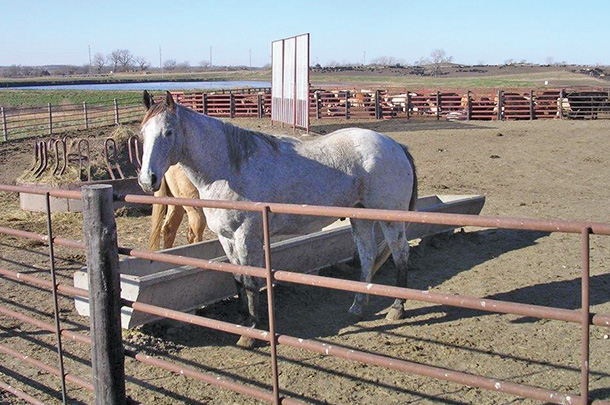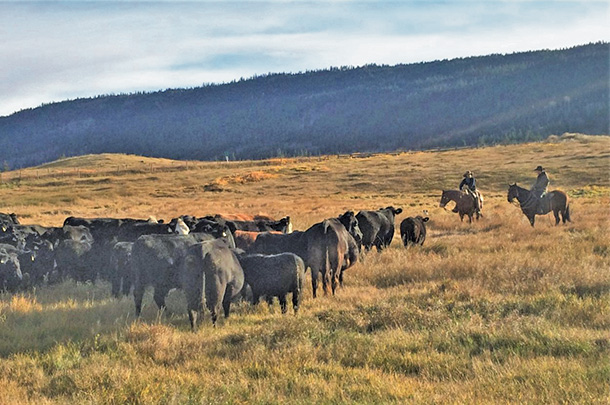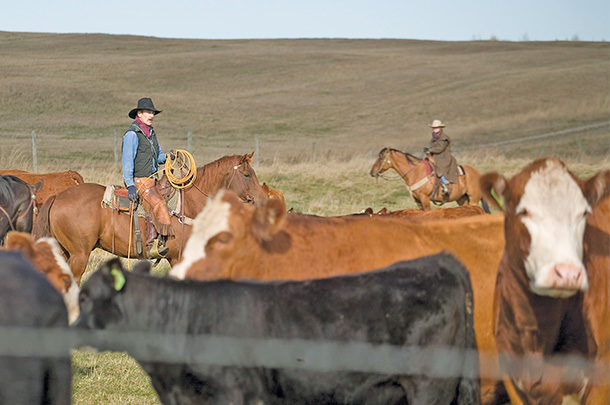Accidents and injuries on North American farms and ranches occur in a variety of ways, many times caused by moving equipment or tools, but often they involve horses and riders. To stabilize the relationship between these entities, key provisions involve preparing the working horse and rider for what they’re being asked to do as a unit, says Reg Steward, AgSafe B.C.’s provincial ranching safety consultant and superintendent of field operations.
Matching capabilities with tasks
“It’s important to ensure a horse is capable of handling the anticipated stress and strain of a task, and that they’re not put into an uncomfortable and challenging situation they’re not ready to handle, either mentally or physically,” Steward says. “The same is true for riders. It’s critical the risk level they’re prepared to take is reasonable and suits their ability. Determining and matching the right horse for the right job is quintessential to safety in any context.”
He believes agricultural operations can help achieve these risk management goals through a combination of training and experience, allowing time for cowboys to develop horses in a contained and controlled environment. Like new human employees, they also need to be brought along slowly until they become a cohesive working unit with their rider, knowing and understanding their collective limits.
“I use the term ‘progressive development,’” Steward says. “It means the combined forward movement of the rider and horse, working and growing together for comfort with the task they’re asked to do. This greatly reduces risk by not putting them in situations neither is prepared for or developed to handle.”
He encourages producers to treat this process as routine, understanding time allocated or allowed for this development will eventually pay off, resulting in a more valued employee team successful in any environment.
 A pen rider mount at Timmerman feedlot in Nebraska. Photo provided by Kathy Anderson.
A pen rider mount at Timmerman feedlot in Nebraska. Photo provided by Kathy Anderson.
“If we adapt our mindset to see the horse as an employee, a living, working tool with a mind of its own, and allow designed and intentional development time for a solid working relationship, the ranch benefits from increased efficiency. Horse and rider will work safely, effectively and efficiently with the right animal, at the right time, doing the right job.”
By the numbers
A recent Farm and Ranch Health and Safety survey, 2011-15, completed by the Central States Center for Agricultural Safety and Health (CS-CASH) covering Iowa, Kansas, Minnesota, Missouri, Nebraska, and North and South Dakota, compiled work-related injury data from over 10,000 large and small farms, feedlots and ranches.
They found livestock-related injuries including horse and rider events made up 26% of all accidents, more than tractor, machinery and ATV incidents combined.
Inexperience and understanding cattle behavior
Kathy Anderson, extension horse specialist at the University of Nebraska – Lincoln, believes the main causes of these injuries are inexperience and cattle behavior.
“Horses are diverse, some quiet, some spooky, some old and some young. It’s not as simple as good or bad; it just takes time to become comfortable with the work,” she says. “The rider is the other factor. Experience allows more understanding of young or nervous mounts. An inexperienced rider on an inexperienced horse is not a smart combination. Sometimes the horse must help the rider, and sometimes the rider must help the horse. It depends on the situation.”
She stresses it’s vital to understand cattle demeanor. Some pens will be comfortable with humans and horses, while others rank.
“Good livestock people watch and read animals. Learn the look in their eyes and body language. How they hold their ears and move about. Should we back off or press? There’s a balance there.”
She adds that handling practices are huge. For stress reduction, being cognizant of pressure reduces stress for cattle, horses and riders. This type of handling promotes safer situations for all involved.
Mentorship and supervision
 Reg Steward and Ethan Desmond lead cattle at the Onward Mission Ranch at 150 Mile House, British Columbia. Photo provided by Reg Steward.
Reg Steward and Ethan Desmond lead cattle at the Onward Mission Ranch at 150 Mile House, British Columbia. Photo provided by Reg Steward.
Steward believes lowering injury risk involves a consistent system of mentorship and supervision. To address the all-important issue of due diligence and, in some jurisdictions, regulatory compliance, competency must be determined and recorded. These observed and developed skill sets characterize how a worker does their job.
He discourages a ticketing or licensing certificate type of mentality, rather encouraging the pursuit of competency, addressing both due diligence and compliance.
“If experienced people aid the youngsters, or novices, we develop competency under the watchful eye of a supervisor,” he says. “My theory and safety philosophy revolves around simplicity and the concept of ‘tell me, show me and watch me.’ The worker is told and shown how to do the job, and then they’re watched in their performance of the job. This approach makes safety a routine part of how business is done.”
Infrastructure and mental stress
Steward explains that infrastructure and facility design also play a large role in reducing incidents and injuries. Well-thought-out designs relieve stress too often associated with cattle handling. Situations are safer and more manageable for all in a system supporting ease of flow and handling. Simply by completing slight design modifications, it’s possible to reduce or eliminate the need for handlers to enter harm’s way or make risky interventions.
He suggests maintaining a well-designed facility is key.
“If there’s disrepair, boards, planks and wires missing, this invites escape, requiring a different level of response. Eliminating these types of things, maintaining efficiently placed and working gates that open and close easily from horseback is a huge factor in worker safety.”
He notes the mental stress of working in a facility not conducive to good flow negatively affects workers and impacts retention and duration.
“The happiness and overall well-being of the employee doing their daily tasks is much more important than often thought. Negativity and poor mental health caused by rundown facilities creates staff retention concerns and even health problems.”
Anderson agrees and adds positive communication between co-workers can ease mental strains.
“Communication between cowboys is critical. Even for experienced riders, it’s key to ask questions when dealing with new groups of livestock or mounts,” she says. “Not letting pride or arrogance get in the way and being honest with a person’s abilities will greatly reduce the risk of injury.”








